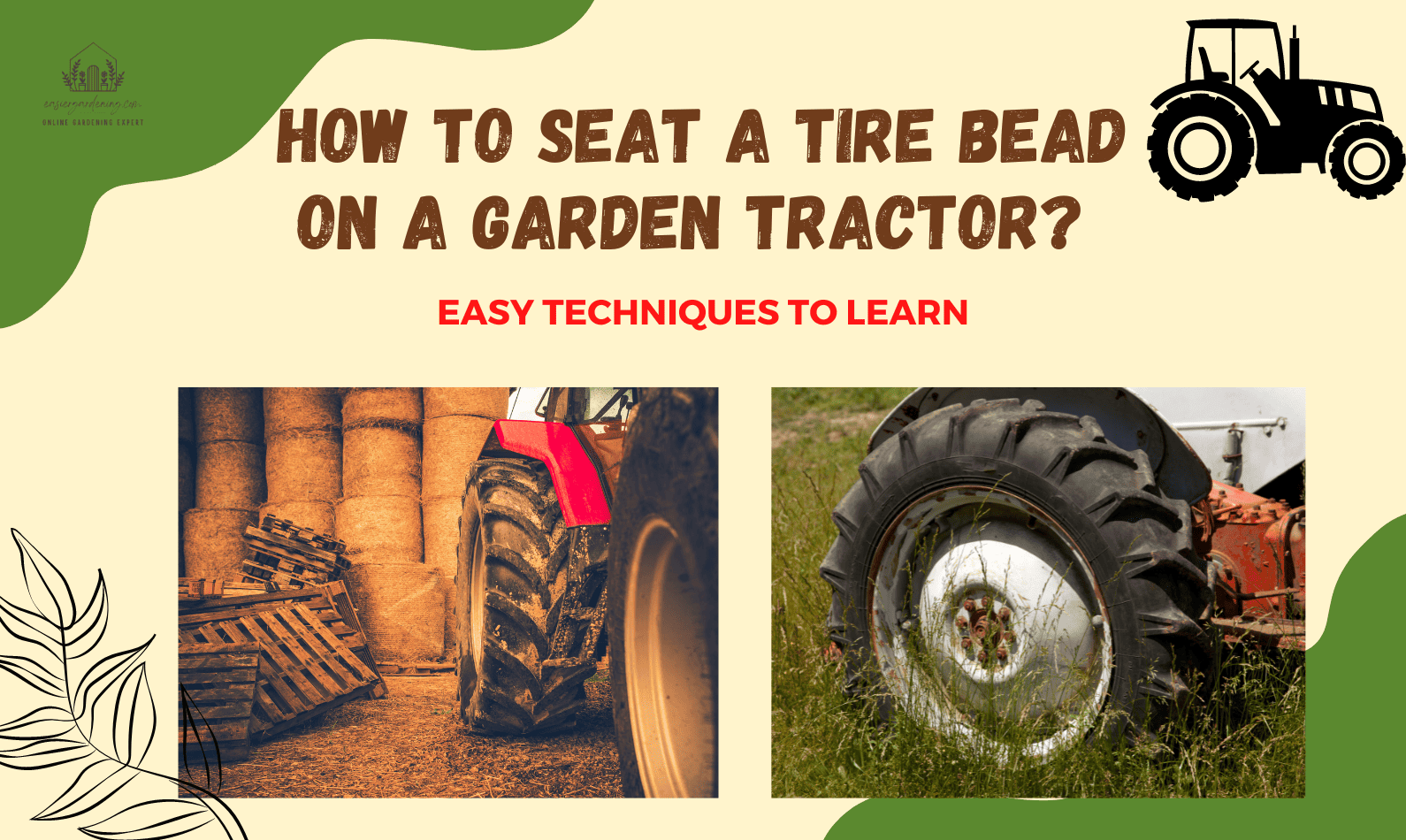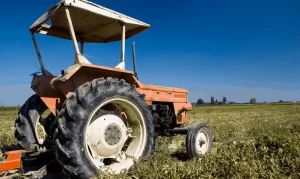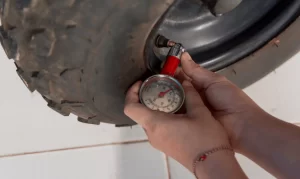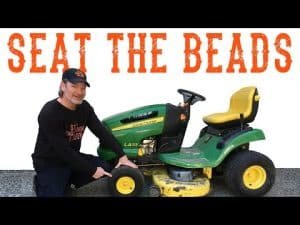How to Seat a Tire Bead on a Garden Tractor? Tires tend to go flat over time. In most situations, what you need to do is inflate the tire. However, the tire bead will fall off the rim at times. To re-inflate your tire, you must first seat it on the bottom.
The tire’s inner edge that is fitted to the rim when the tire is inflated is referred to as a tire bead. When it comes loose, the tire deflates, making your tractor a burden. In the video below, learn how to seat a tire bead on a garden tractor.
Contents
- Why Is Your Tire Losing Air?
- Temperature
- Osmosis
- Wheel Damage
- Tire Damage
- What Do Tires Do?
- Different Methods on How to Seat a Tire Bead on a Garden Tractor?
- Seating a Tire Bead With Fire (the Risky Way)
- Seating a Tire Bead With Air Pressure (the Safe Way)
- Step 1: Selecting Your Tools
- Step 2: Secure the Tire
- Step 3: Twist
- Step 4: Take out the Valve Stem
- Step 5: Make Use of the Air Compressor
- Step 6: Replace the valve stem
- Step 7: Cut the Rope
- When to Use Each Method?
- Fire Method
- Wrap-around Technique
- Conclusion: How to Seat a Tire Bead on a Garden Tractor?
Why Is Your Tire Losing Air?
How can you tell if your tire is unusually losing air? A typical tire can lose 1-3 PSI per month, so if you’re losing more than that, you should get it tested.
The loss of air can be attributed to four factors.
- Wheel damage
- Temperatures
- Tire damage
- Osmosis (naturally)
Temperature
In cold weather, air condenses; in warm weather, it expands. It is probably something you learned in chemistry class. The car can sense lower PSI levels within the tire in the winter.
When you start driving, the PSI will rise as the air particles within the tire heat up. It will continue for about 10 minutes until the air stops expanding.
Osmosis
Once again, I’m referring to your chemistry class. Because of the high concentration, the air naturally needs to flee the tire. It wishes to be released into the vast world beyond the tire. As a result, the opportunity for air to escape will result in your tire losing pressure.
Wheel Damage
The valves inside the wheels may be leaking more air than they should. These deteriorate over time as a result of environmental conditions or bumpy roads.
Another issue with the wheels is that they could have been bent or broken. When a wheel section is bent, the tire will not fit securely around the wheel, allowing pressure to escape through the ill-fitting sections.
Tire Damage
We have tire damage because the roads aren’t as safe as we’d like to believe. A loose nail or other sharp objects can slash the tires at times. Small tears can cause the tire to lose air gradually. If the beads are damaged, air can escape through the small opening between the bead and the rim.
The bead may not even have to be damaged; it may simply loosen around the rim and cause the tire to lose air. We’ll show you how to get it back in place.
What Do Tires Do?
Good luck driving a car with just a steering wheel. The steering wheel and tires work together in the same way as our bodies and minds do. The tires are not only in line with the steering wheel but also in sync with the engine. They convert the engine’s power into motion.
The strain within them causes them to move and support the weight of the vehicles. Tires would not have kept up the vehicle or absorbed road shocks if it weren’t for their bouncy quality. It’s amazing how one tiny vehicle feature can make such a big difference.
Different Methods on How to Seat a Tire Bead on a Garden Tractor?
There are two approaches to reseating a tire bead. The first entails the use of flames. This approach is not suitable for smaller tires or novice drivers. The following approach involves using an air compressor and a rope or string to increase the pressure.
Seating a Tire Bead With Fire (the Risky Way)
Because of the potential dangers, I do not suggest using this form. It fits best for larger tires; smaller ones should be avoided. Everything you’ll need is some starter fluid and a way to light it on fire. You’ll spray the fluid into the space between the tire bead and the rim, then ignite it. The pressure from the fire would return the bead to its original position.
After ensuring that the fires have been extinguished, fill the tire with air until it deflates. Take care because the air coming out of the tire is extremely hot! Don’t reach the PSI level when inflating the tire. The maximum PSI is written on the surface of the tire. If you decide to use this tool, you should proceed with caution. Keep a fire extinguisher nearby in case of an emergency.
Seating a Tire Bead With Air Pressure (the Safe Way)
This approach necessitates the use of certain muscle strengths. The smaller the tire you’re working with, the less power you’ll need to complete these moves.
Step 1: Selecting Your Tools
You’ll need something to tie around the tire’s circumference. It should be elastic enough to bend and strong enough to withstand the tire’s pressure. You have a few options.
- Rope
- Tie-down straps
- Ratchet straps
Step 2: Secure the Tire
Run your chain, or whatever you’ve chosen, along the length of the tire, making sure it’s centered. If it’s not concentrated, the rope can come undone when you’re pumping air into the tire.
You don’t need to tie the rope very tightly; that will be done in the next stage.
Step 3: Twist
Take a screwdriver or some other metal appliance that looks like it. Wedge it under the newly formed knot and twist it. This tightens the rope around the tire, increasing the pressure inside.
This move can present some difficulties for you. The first twist is often the most difficult. If you complete it, the rest of the job will be a piece of cake.
Step 4: Take out the Valve Stem
This is an optional move, but it is still recommended. The air will flow freely and without constraint by removing the valve stems. It is much faster to fill the tire with air when you are not constrained by something.
Step 5: Make Use of the Air Compressor
Fill the tire with air until the tire bead protrudes from the bottom. You’re already adding pressure to the tire, so don’t over-inflate it.
Step 6: Replace the valve stem
The valve stem will keep the pressure in the tire from escaping. If the pressure escapes, the tire bead will re-loosen around the rims. Do you want to go through all of that again?
Step 7: Cut the Rope
Now that no external pressure is applied, you can fill the tire to the full PSI level and call it a day! Overfilling the tire with air can cause it to burst. You should know the full PSI of your tire ahead of time and fill it accordingly. If you’re unfortunate enough, you’ll be in the path of an explosive tire, which can result in severe injuries and even death. As a result, when applying pressure to your tire, exercise extreme caution.
Read more about Best Garden Tractor Under $3000
When to Use Each Method?
-
Fire Method
If you’re working with one of the tractor’s larger tires and can’t quickly use the wrap around the circumference process, try the fire method. It will be difficult to tie a rope around larger tires, particularly if working alone.
Learn more about the how to find a Dump Cart For Lawn Tractor
Smashed tires and the explosive method are inextricably linked. You won’t tie the rope around the tire because there is no pressure in it. As a result, you’ll have to resort to the alternate method.
-
Wrap-around Technique
Unlike the fire method, this method is ideal for smaller, more manageable tires. If you only have a small amount of space to repair your tire, you can use this tool. It doesn’t take up much room and won’t catch fire in your garage.
It works best when the distance between the tire bead and the rim is small. It means that there is internal strain, which is needed for this to function.
Conclusion: How to Seat a Tire Bead on a Garden Tractor?
You might be thinking, “Why would I want to fix the tire myself?” So, are you willing to go through the trouble of getting the tire to a mechanic? A small tractor tire is simple to fix in your garage.
Learn How to Fix a Wheelbarrow Tire? Easy Technique to Learn
When it comes to larger tires, you can consider the benefits and drawbacks of going to a mechanic against using the firing process. Fixing your tire can be your best choice if you’re a natural handyman with some experience. It will save you money and time. After you replace the tire, your garden tractor will be ready to use right away. I can’t emphasize enough how important it is to take safety precautions when working with tires on your own, particularly if you want to work with flammable fluid. Never work alone; always have someone nearby in case something goes wrong.




